|
|||||||||||||||||||
|
|
|||||||||||||||||||
|
|
STUDIES OF RADIAL VELOCITY SYSTEMATICS IN NEWSIPS (High Dispersion)
Myron Smith
The following are results of several studies performed to evaluate the wavelength accuracy of NEWSIPS high dispersion data. These studies were prompted by a report by J. Holberg (Holberg, Barstow, Sion, ApJS, 119, 207, 1998) that high-dispersion SWP spectra of several white dwarfs processed through NEWSIPS give rise to different radial velocities than those obtained from well-calibrated optical spectra.
Most of these studies are focused on spectra obtained with the SWP camera. The study includes the velocity behavior with both time and wavelength, the differences with respect to the Copernicus system for tau Sco, with respect to IUESIPS processing, and finally between large and small apertures. We chose as a standard reference the sharp-lined B0V star tau Scorpii for several of these tests. We also exhibit RV differences between SWP and LWP/LWR cameras of tau Sco.
In all cases, the measurements discussed below were made by comparing pairs of various spectra using the IUEDAC analysis tool CRSCOR.
- Study 1:Radial Velocity of tau Sco & White Dwarf Images with epoch (SWP)
- Study 2:Radial Velocity Difference with Wavelength, IUESIPS - NEWSIPS
- Study 3:Radial Velocity Difference with Wavelength, IUESIPS - Copernicus
- Study 4:Velocity Offsets Between Large and Small SWP Aperture
- Study 5:Radial Velocity with Time: NEWSIPS - Copernicus (tau Sco, SWP)
- Study 6:Radial Velocity Difference for Small & Large Apertures for LW Cameras
- Study 7:Radial Velocity Difference Between SWP and LW Cameras
- An Appendix is provided listing the spectra used in these studies and acknowledgments.
Study 1
Radial Velocity of tau Sco & White Dwarf Images with Epoch (SWP)
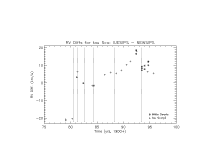 |
| Figure 1 |
|---|
Figure 1 shows the IUESIPS - NEWSIPS radial velocity difference with time
computed
from several large-aperture, high-dispersion SWP images of tau Scorpii and
the white dwarfs BD 2111+49, R2214-49, HD340611, G191-B2B for the 1190--1720
Angstrom region. The times of a number of changes implemented into the IUESIPS
are denoted by verticle dotted lines. These changes are expected to have
affected the IUESIPS wavelengths to greater or lesser degrees (courtesy, C.
Imhoff).
Note the correspondence of various discontinuities and trends in the velocity difference with the times of modifications to the IUESIPS software noted. This correspondence implies that most or all of the RV fluctuations time are caused by updates to the IUESIPS wavelength calibration. This plot, including the positive during the middle of the mission and the complicated time dependence, is very similar to that found in a study by (Holberg, Barstow, & Sion, ApJS, 119, 207, 1998); our white dwarf images comprise a subset of their dataset.
The implied constancy of the SWP NEWSIPS wavelength system with time is confirmed in Study 5 (Fig. 7), which compares NEWSIPS results with those high-quality data from the Copernicus atlas of tau Sco.
Study 2
Radial Velocity Difference with Wavelength, IUESIPS - NEWSIPS
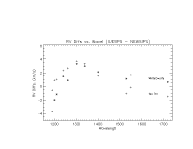
|
| Figure 2 |
|---|
Because the zero point of the IUESIPS RVs is a function of epoch, we used an arbitrary zero point appropiate to 14 white dwarf images studed by Holberg et al. (for listing, see Appendix). The radial velocities of the tau Sco images have been shifted to match the mean curve for the white dwarfs. (The mean difference in RVs for these source types differs because of the different distributions of times at which the images were taken (STUDY 1).)
Study 3
Radial Velocity Difference with Wavelength, IUESIPS - Copernicus
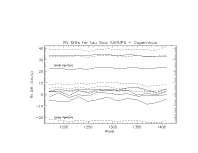 |
| Figure 3 |
|---|
Study 4
Velocity Offsets Between Large and Small SWP Aperture
 |
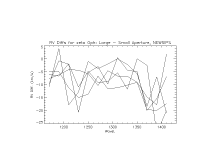 |
| Figure 6 | Figure 7 |
|---|
Study 5
Radial Velocity with Time: NEWSIPS - Copernicus (tau Sco, SWP)
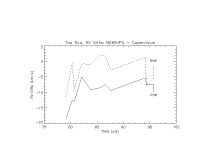
|
| Figure 8 |
|---|
Study 6
Radial Velocity Difference for Small & Large Apertures For LW
Cameras
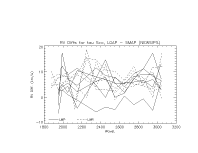
|
| Figure 9 |
|---|
If one LWP result is excepted, the large-aperture minus small-aperture RV offsets are virtually identical for the two long-wavelength cameras.
C. Imhoff has pointed out (priv. comm.) that one can predict a difference in offsets due to a systematic centering error for the "FES underlap mode" used to guide on bright stars. This amounts to an equivalent RV difference, LGAP - SMAP, of -5 km/s for SWP and +5 km/s for LWP/LWP. These results appear to be consistent with our results for tau Sco for all three cameras (Studies 4 & 6) and zeta Oph for SWP (Study 4).
Study 7
Radial Velocity Difference Between SWP and LW Cameras
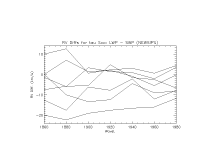 |
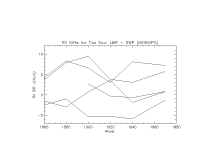 |
| Figure 10 | Figure 11 |
|---|
A small wavelength overlap range (nearly 150Å) between SWP and LWP/LWR spectra can be used to provide a wavelength comparison for images of hot stars. In Figures 10 and 11 we show the equivalent velocity shift of pairs of common-epoch, small-aperture images of tau Sco. The results show an equivalent velocity shift, relative to SWP, of -5 km/s for LWP and +2 km/s for LWR, i.e., an LWR - LWP offset of +7 ±2 km/s.
|
|
|




 Follow Us
Follow Us